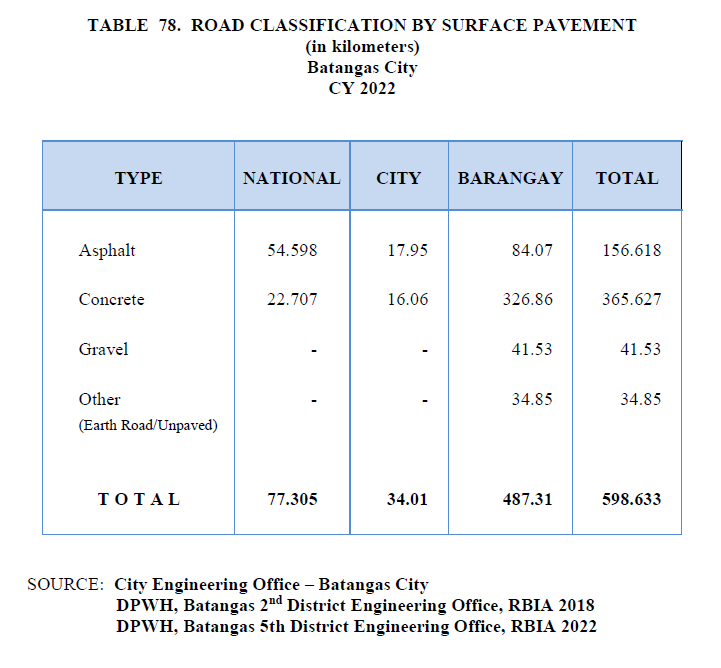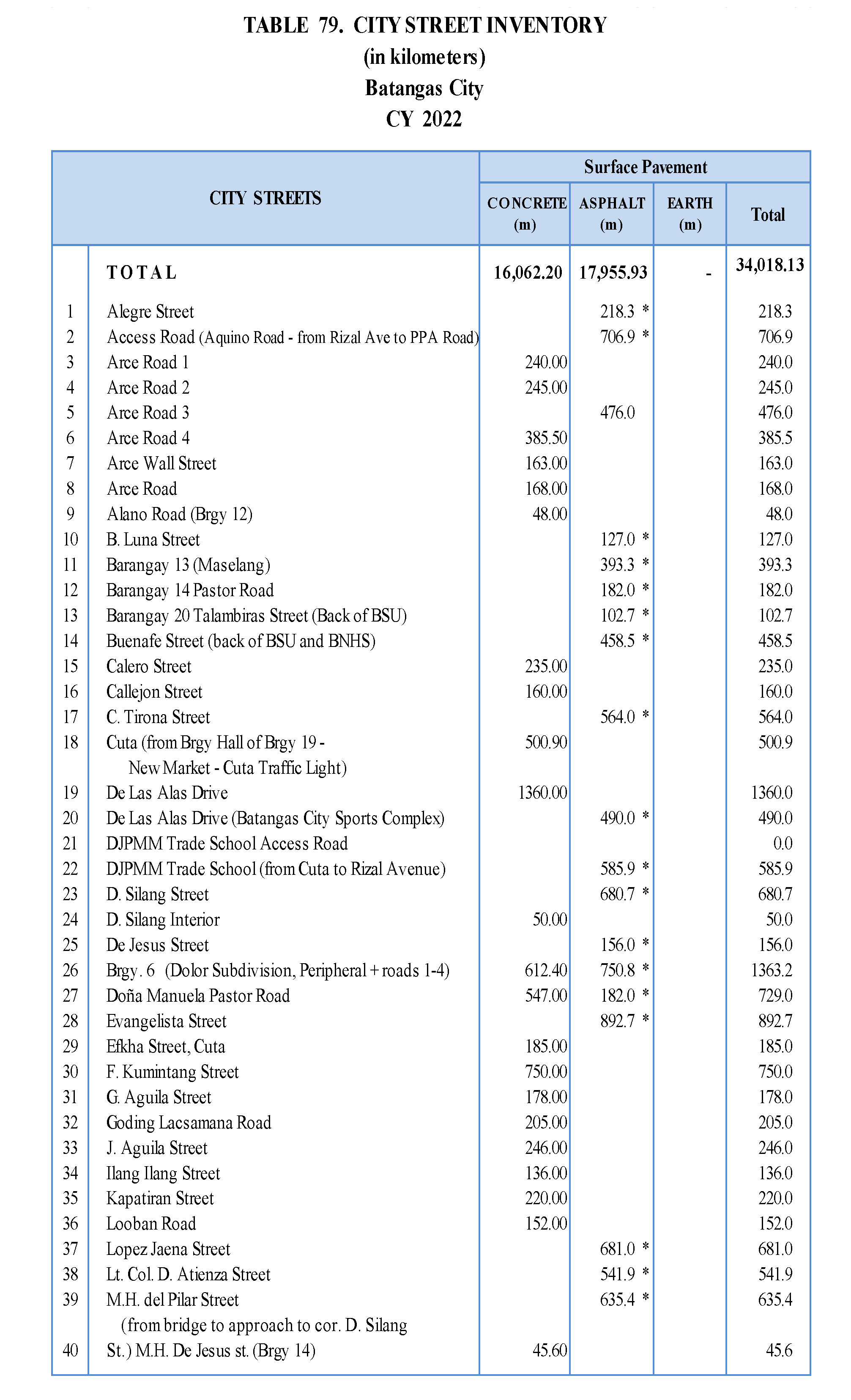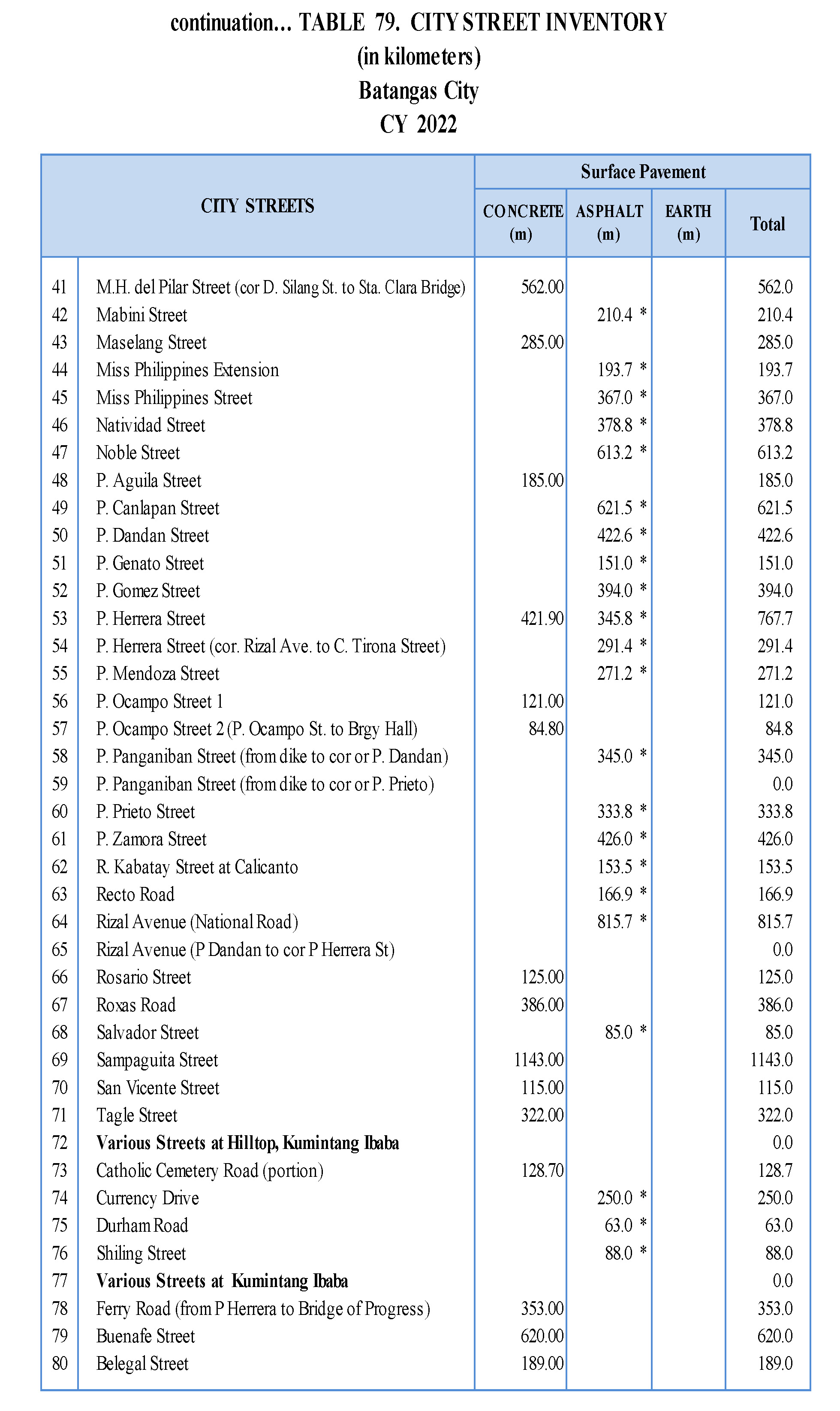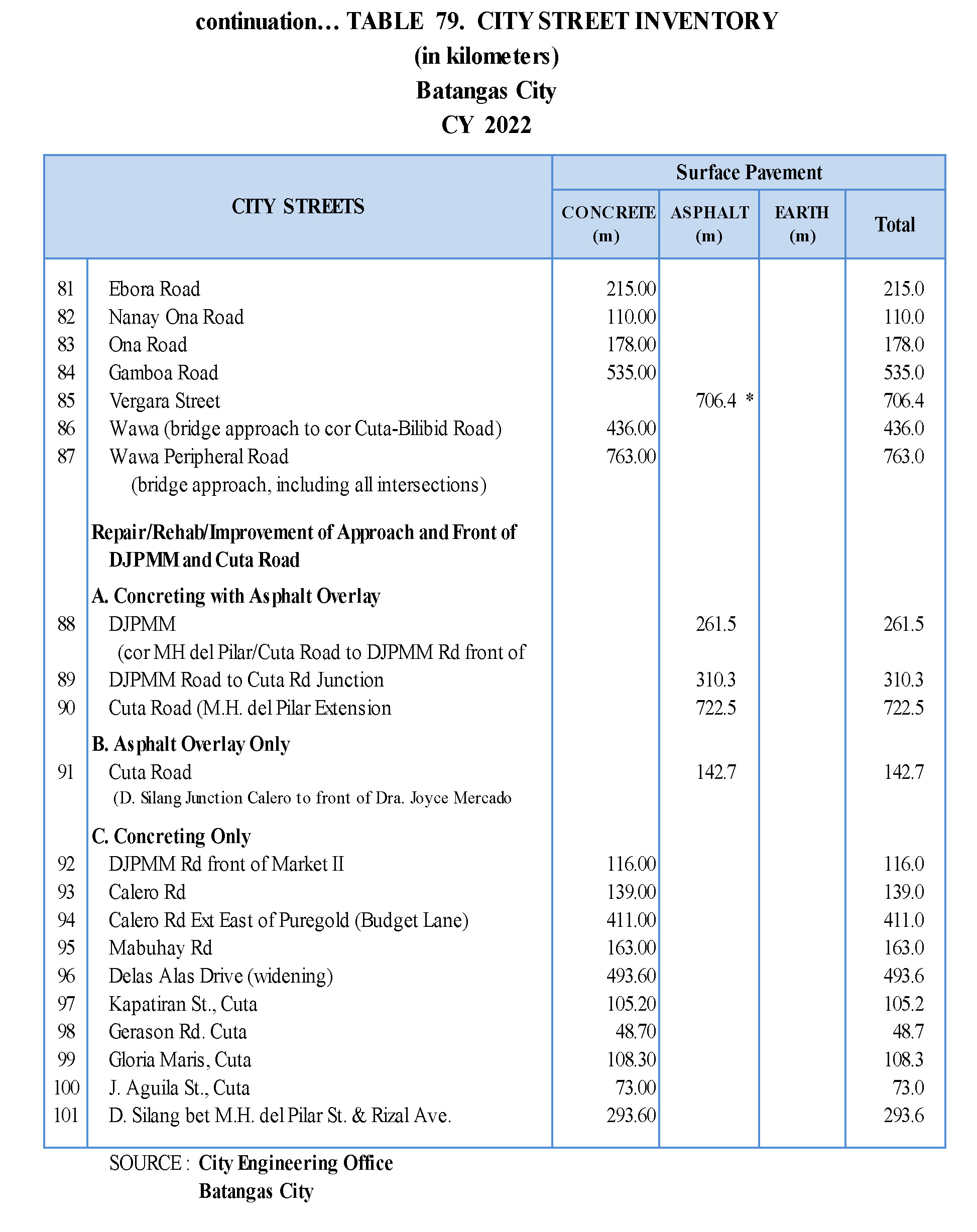- Details
- Wednesday, 03 January 2024 - 9:02:00 PM

ROADS, BRIDGES AND FLYOVER
As of CY 2022, the total length of all roads in the city is approximately 606.825 km. comprised of 77.305 km of national roads (Table 81), 34.01 km of city roads (Table 79), and 487.31 km. of barangay roads (Table 80). The inventory (Table 78) showed that the total lengths of asphalt paved roads are 160.808 kms, concrete paved roads are 365.627 kms, while gravel roads are 41.53 kms and the unpaved road totaled to 34.85 kms. Batangas City’s national road is now under DPWH, Batangas 5th District Engineering Office, RBIA 2021 explaining the decrease in the inventory. Still the record indicated that there is an increase in the length of barangay roads in the city as compared to the year 2019 which is 451.81 kilometers.
Table 82 listed Fifty-six (56) existing bridges (18 national and 38 local) and one (1) flyover along national and barangays roads in Batangas City including the length in meters, descriptions and conditions.




TRANSPORTATION
Land Transportation
Land transportation services in the city are readily available through public transports like buses, jeepneys, privately owned cars, vans, jeeps, and tricycles. For trips going to Metro Manila and neighboring provinces, the commuters can avail the public utility bus system, such as ALPS the Bus Inc., Batangas Star Express, Batman Star Express, Ceres Transport Inc., DLTBCO,
Gold Star Bus Transit Corp., JAM Lines Inc., KL CNG Bus Transport, N. Dela Rosa, RRCG Transport System, Saint Rose Transit, and Supreme Trans liner Inc. The opening of the Southern Tagalog Access Road (STAR) in April 2008 which is a toll way component of the West Philippine Nautical Highway with a length of about 42 km. from Sto. Tomas, Batangas to the Batangas Port in Batangas City which is interconnected to the South Luzon Expressway (SLEX) shortened the travel time from Metro Manila to Batangas City by about thirty to forty-five minutes.
With the implementation of the City's New Traffic Ordinance, public utility jeepneys routes thru color and number coding scheme have been enforced. Parking areas and PUJ terminals have been designated for the different routes. In 2022, the PUJ franchises issued by the LTO were 4,758 units but only 2,684 units were granted with mayor’s permit. With the devolution of power to grant franchises for tricycle operation from the Land Transportation Regulatory Board (LTFRB) to the Batangas City Government, tricycle operators can now apply for their franchise from
the Transportation Development and Regulatory Office under the Office of the City Mayor. Like the public utility jeepneys, tricycles plying in the poblacion operate also through a color-coding system. A total of 2,251 tricycle franchises were issued by the TDRO for CY 2022 but only 1,329 units were granted with mayor’s permit.
In an effort to address the worsening traffic situations in Batangas City, traffic signal lights were installed along the seven (7) major intersections Socio-Economic Physical and Political Profile 2022 84 in the city. These have been upgraded to LED traffic signal lights with electronic timers. An estimated 300 traffic signage were put up as well.
The city government installed a Closed-Circuit Television (CCTV) Camera along P. Burgos St. and Rizal Avenue l as components of city transportation/traffic management program. Additional CCTV cameras were installed along strategic locations/intersections including the Calumpang Bridge and the City Integrated Transport Terminal at Diversion Road. On August 10, 2015, the City Government of Batangas and Batangas Ventures Properties and Management Corporation enter into a Contract of Lease thru a Public-Private Partnership for the development, management, operation and maintenance of the Batangas City Grand Terminal (BCGT) for a period of twenty-five (25) years. The city government property is located along the Batangas City Port Diversion Road in barangay Alangilan with an area of 2.1351 hectares more or less. The BCGT is divided into two (2) phases. The first phase is the construction and operation of the transport terminal proper for buses and PUVs with LTFRB franchise. The second phase is the development of the commercial area of the project.
- Air Service
There is no existing airport in Batangas City. Helicopters use the Batangas National High School ground, the Quezon Memorial Stadium, the PPA facilities and the Camp General Miguel Malvar (PNP Provincial Office Compound) in barangay Alangilan as landing and takeoff areas.
- Water Transportation
The Batangas City International Port is considered as one of the busiest ports in the country. As per Japan International Corporation Agency (JICA) study, the Batangas Port has the capacity to serve as the Main Gateway to and from the islands of Mindoro, Marinduque, Romblon and Palawan (MIMAROPA), the Visayas and Mindanao. The Philippine Port Authority (PPA) was rehabilitated, developed and improved in order to efficiently serve not only the neighboring island provinces as well as other countries.
During Phase 1 of the Batangas Port Development Project (BPDP) construction of high impact facilities were constructed such as modern and efficient passenger terminals and warehouse. Covering an approximate area of 22 hectares, this was completed in 1999 at a cost of Php1.6B. BPDP Phase 1 is responsible for serving the domestic vessels bound for Mindoro, Romblon, Masbate, Iloilo, Aklan, Cebu and Cagayan de Oro. The port also caters to non-containerized foreign vessels. Phase 1’s facilities include different berths of different sizes capable of serving multiple functions and passenger terminals. Its General Cargo Berth has a 2.9-hectare open yard that has a capacity of 300,000 tons in terms of volume, and can accommodate five (5) small vessels. Additionally, it has two (2) Multi-purpose Berths, one (1) Foreign Berth, seven (7) Fast craft Berths, 14 Roro Berths. The number of passenger vessels that can be accommodated at any given time is 21 (Roro and Fast craft) but collectively, BPDP Phase 1 can accommodate 29 vessels, including trampers at any given time.Batangas Base Port Phase II or the Batangas Container Terminal (BCT) was constructed to international container vessels. The Port was developed to complement the Port of Manila and meet the demands of the CALABARZON and Southern Tagalog provinces. The project began on January 16, 2002 and the Philippine Ports Authority operated the Batangas Container Terminal upon its completion in August 2005. It has an estimated cost of approximately Seven Billion Pesos.
- Water Supply
The Batangas City Water Supply System was jointly constructed by the governments of the Philippines and the United States of America in 1926. It was first supervised and managed by the Bureau of Public Works while the local operation and management were undertaken by the Batangas Municipal Government. In 1957, the system was turned over to the National Waterworks and Sewerage Administration (NAWASA) and fourteen (14) years later, the city government decided to manage its own system.
Under Presidential Decree No. 128, the Batangas City Water District (BCWD) was subsequently created under the mandates of the Local Water Utilities Authority (LWUA) which provided financial and technical assistance to the water district. The waterworks system was formally transferred by the city government to the BCWD in 1975.
Starting March 1, 2018 under the Public Private Partnership (PPP), the Batangas City Water District (BCWD) enter into a joint venture agreement with the Prime Water Corporation. The company has earmarked an estimated amount of Ph4.6B for the upgrading and rehabilitation of the water system of Batangas City. One of the priority projects is to put up a septage management facility by 2020 in compliance with the Clean Water Act of 2004.
- Rural Barangays Water Supply
Thru the financial assistance of the USAID, seven (7) rural barangays have been provided with waterworks system under the Barangay Water Program (BWP) in the early 1980’s which are still presently operating and can be showcased as examples of successful sustainable projects. These barangays were Tingga Itaas, Concepcion, Tulo, Banaba East, Balete, Sampaga and Sampaga West-Pallocan East.
To date, a total of seventy-three (76) Rural Waterworks and Sanitation Projects (RWSP) with level III services were established by the city government and operating in fifty-six (56) barangays of the city. (Table 70)
At present, resident of several barangays particularly those located within the watershed areas of Mt. Banoy like barangays Cumba, Haligue Silangan/Kanluran, Maruclap, Pinamucan Silangan, Talahib Payapa/Pandayan, Talumpok Kanluran/Silangan and San Jose Sico depend largely for their water supply requirement from the springs with storage/catchment facilities.
- Power Supply
Out of the total 105 barangays in the city, ninety-nine (99) barangays are being provided by the Manila Electric Company (MERALCO) with electricity. But some portions of barangays San Jose Sico, Talumpok Silangan and Talahib Pandayan are being served by the Batangas Electric Cooperative II (BATELEC II).
The residents of the six (6) barangays located in Verde Island depend on diesel fired power generators and solar energy devices for their electricity requirements. In 2018, through the Micro Grid Program of the City Government and USAID, a portion of Barangay San Agapito in Isla Verde was provided with solar panel as source of power. The program which is being operated by Meralco through lease agreement with the City Government is benefiting around 40 households.







